一、搭建mybatis
|加入pom文件
<dependencies>
<dependency>
<groupId>org.mybatis</groupId>
<artifactId>mybatis</artifactId>
<version>3.5.9</version>
</dependency>
<dependency>
<groupId>org.projectlombok</groupId>
<artifactId>lombok</artifactId>
<version>1.18.22</version>
</dependency>
<dependency>
<groupId>ch.qos.logback</groupId>
<artifactId>logback-classic</artifactId>
<version>1.2.11</version>
</dependency>
<dependency>
<groupId>org.junit.jupiter</groupId>
<artifactId>junit-jupiter-api</artifactId>
<version>5.8.2</version>
<scope>test</scope>
</dependency>
<dependency>
<groupId>mysql</groupId>
<artifactId>mysql-connector-java</artifactId>
<version>8.0.28</version>
</dependency>
<dependency>
<groupId>com.alibaba</groupId>
<artifactId>druid</artifactId>
<version>1.2.8</version>
</dependency>
</dependencies>
|配置mybatis-config.xml核心配置文件在resources目录下
<?xml version="1.0" encoding="UTF-8" ?>
<!DOCTYPE configuration
PUBLIC "-//mybatis.org//DTD Config 3.0//EN"
"http://mybatis.org/dtd/mybatis-3-config.dtd">
<configuration>
<environments default="development">
<environment id="development">
<transactionManager type="JDBC"/>
<dataSource type="POOLED">
<property name="driver" value="com.mysql.cj.jdbc.Driver"/>
<property name="url" value="jdbc:mysql://localhost:3305/db?useUnicode=true"/>
<property name="username" value="root"/>
<property name="password" value="2061"/>
</dataSource>
</environment>
</environments>
<!-- 引入映射文件-->
<mappers>
<mapper resource="mappers/UserMapper.xml"/>
</mappers>
</configuration>
|创建mapper接口相当于以前的dao(接口和实现方法),mybatis是面向接口编程。
@Data
@NoArgsConstructor
@AllArgsConstructor
public class User {
private Integer id;
private String username;
private String password;
private Integer age;
private String sex;
private String email;
}
|创建mapper接口名字就叫UserMapper。
|映射文件中的namespace要和mapper接口的全类名一致。
|映射文件中的id要和mapper接口中的方法名一致,才可以匹配sql语句
|创建UserMapper.xml
<?xml version="1.0" encoding="UTF-8" ?>
<!DOCTYPE mapper
PUBLIC "-//mybatis.org//DTD Mapper 3.0//EN"
"http://mybatis.org/dtd/mybatis-3-mapper.dtd">
<mapper namespace="com.jsm.mapper.UserMapper">
<select id="insertUser">
insert into t_user1 values(null,'admin','123',23,'男','123@qq.com')
</select>
</mapper>
|测试
//加载核心配置文件
InputStream is = Resources.getResourceAsStream("mybatis-config.xml");
//获取SqlSessionFactoryBuilder
SqlSessionFactoryBuilder sqlSessionFactoryBuilder = new SqlSessionFactoryBuilder();
//获取sqlsessionfactory
SqlSessionFactory sqlSessionFactory = sqlSessionFactoryBuilder.build(is);
//获取SqlSession为了访问sql语句,事务自动提交
SqlSession session = sqlSessionFactory.openSession(true);
//获取mapper接口对象,可以自动实现接口。返回实现类的对象
UserMapper mapper = session.getMapper(UserMapper.class);
//测试功能
Integer result = mapper.insertUser();
System.out.println("result:"+result);
}
|测试查询
sql语句文件有一个参数resultType(默认的映射关系(com.jsm.pojo.User))和resultTypeMap(自定义的默认关系(多对一或字段名和属性名不一致时用)),设置返回的类型。
|查询所有返回List<User> getAllUser();
<!-- getUserById-->
<select id="getUserById" resultType="com.jsm.pojo.User">
select * from t_user where id = 9
</select>
<!-- getAllUser-->
<select id="getAllUser" resultType="com.jsm.pojo.User">
select * from t_user
</select>
|测试同上

<!-- 设置别名-->
<typeAliases>
<typeAlias type="com.jsm.pojo.User" alias="User"/>
<!-- 常用的以包为单位,将包下的所有类设置类型别名,就是类名-->
<package name="com.jsm.pojo"/>
</typeAliases>
|映射文件和mapper接口
<!-- 以包为单位
要求:mapper接口所在的包要和映射文件所在的包一致
mapper接口要和映射文件的名字一致
-->
<package name="com.jsm.mybatis.xml"/>
二、MyBatis获取参数值的两种方式
|${} //字符串拼接
#{} //占位符
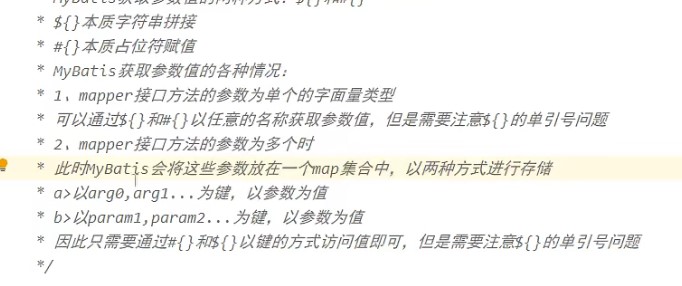
3.若mapper接口方法的参数有多个时,可以手动将参数放在map中
4.mapper接口方法的参数是实体类类型的参数
5.使用注解@param 拥有1和2。
三、mybatis的各种查询功能
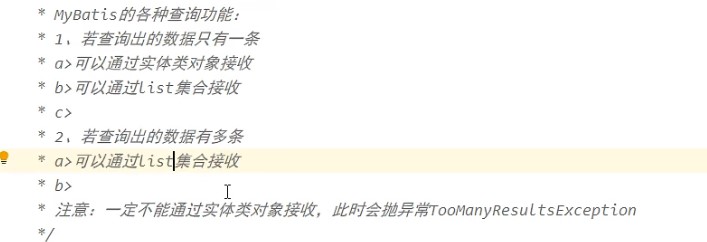
@Test
@DisplayName("查询aLLidtoMap")
public void queryAllToMap(){
SqlSession sqlSession = SqlSessionUtils.getSqlSession();
UserMapper paramMapper = sqlSession.getMapper(UserMapper.class);
System.out.println(paramMapper.getAllMap());
}
@Test
@DisplayName("查询idtoMap")
public void queryIdToMap(){
SqlSession sqlSession = SqlSessionUtils.getSqlSession();
UserMapper paramMapper = sqlSession.getMapper(UserMapper.class);
Map<String,Object> map = paramMapper.getIdMap(3);
System.out.println(map);
}
@Test
@DisplayName("查询Count")
public void queryCount(){
SqlSession sqlSession = SqlSessionUtils.getSqlSession();
UserMapper paramMapper = sqlSession.getMapper(UserMapper.class);
System.out.println(paramMapper.getCount());
}
@Test
@DisplayName("查询All")
public void queryAllParam(){
SqlSession sqlSession = SqlSessionUtils.getSqlSession();
UserMapper paramMapper = sqlSession.getMapper(UserMapper.class);
List<Params> list = paramMapper.getAll();
System.out.println(list);
}
@Test
@DisplayName("查询")
public void queryParam(){
SqlSession sqlSession = SqlSessionUtils.getSqlSession();
UserMapper paramMapper = sqlSession.getMapper(UserMapper.class);
List<Params> list = paramMapper.getById(3);
System.out.println(list);
}
@Test
public void addParam(){
SqlSession session = SqlSessionUtils.getSqlSession();
ParamMapper paramMapper = session.getMapper(ParamMapper.class);
Integer params = paramMapper.addParams(new Params(null,"root","123",22,"男","123@qq.com"));
System.out.println(params);
}
@Test
public void getParamMap(){
SqlSession session = SqlSessionUtils.getSqlSession();
ParamMapper paramMapper = session.getMapper(ParamMapper.class);
Map<String,Object> map = new HashMap<>();
map.put("username","admin");
map.put("password","123");
Params params = paramMapper.getByParamMap(map);
System.out.println(params);
}
@Test
public void getByNameandPwd() {
SqlSession session = SqlSessionUtils.getSqlSession();
ParamMapper paramMapper = session.getMapper(ParamMapper.class);
Params params = paramMapper.getByParameParam("admin","123");
System.out.println(params);
}
@Test
public void getByName() {
SqlSession session = SqlSessionUtils.getSqlSession();
ParamMapper paramMapper = session.getMapper(ParamMapper.class);
Params params = paramMapper.getByName("admin");
System.out.println(params);
}
@Test
public void getParams() {
SqlSession session = SqlSessionUtils.getSqlSession();
ParamMapper paramMapper = session.getMapper(ParamMapper.class);
List<Params> paramsList = paramMapper.getAllParams();
paramsList.forEach(System.out::println);
}
}
|
List<Params> getById(@Param("id") Integer id);
List<Params> getAll();
Integer getCount();
//使用map接收
Map<String,Object> getIdMap(@Param("id") Integer id);
//接受多个数据
// List<Map<String,Object>> getAllMap();
//或者使用map接受多条数据,得使用不会重复得字段充当键
@MapKey("id")
Map<String, Object> getAllMap();
模糊查询不能使用#{}处理参数。如果使用可以用concat()函数处理
<!--select * from t_user where username like '%${usename}%'-->
<!--select * from t_user where username like concat('%',#{username},'%')-->
<!--常用-->
select * from t_user where username like "%"#{username}"%"
|批量删除,不能使用#{}接受参数
//接口,批量删除
Integer deleteAll(@Param("ids") String ids);
<select id="deleteAll" >
delete from t_user where id in (${ids})
</select>
|根据表名查询
//根据表名查询
List<Params> getByTable(@Param("tableName") String tableName);
//只能用${},#{}会自动加单引号
<select id="getByTable" resultType="Params">
select * from ${tableName}
</select>
四、自定义映射resultMap
|如何解决字段名不一样的问题
1.在sql语句中设置别名
2.全局配置
<!-- mybatis全局配置sql映射驼峰 -->
<settings>
<setting name="mapUnderscoreToCamelCase" value="true"/>
</settings>
3.通过resaultmap自定义映射
<!-- id:唯一标识。type:设置映射关系中的类型-->
<resultMap id="empResultMap" type="Emp">
<id property="eid" column="eid"/>
<result property="empName" column="emp_name"/>
<result property="age" column="age"/>
<result property="sex" column="sex"/>
<result property="email" column="email"/>
</resultMap>
<select id="getAlllEmp" resultMap="empResultMap">
select * from t_emp
</select>
处理多对一映射关系
|级联属性赋值,
<!-- 级联赋值-->
<resultMap id="DeptAndEmp" type="Emp">
<id property="eid" column="eid"/>
<result property="empName" column="emp_name"/>
<result property="age" column="age"/>
<result property="sex" column="sex"/>
<result property="email" column="email"/>
<result property="dept.did" column="did"/>
<result property="dept.deptName" column="dept_name"/>
</resultMap>
<select id="getDeptAndEmp" resultMap="DeptAndEmp">
select * from t_emp left join t_dept on t_emp.did=t_dept.did where t_emp.eid=#{eid}
</select>
|也可以使用association标签
<association property = "dept" javaType = "Dept">
<id property="did" column = "did"/> <result property = "deptName" column = "dept_name"/>
</association>
|分步查询。(常用)。
多的一边sql
<!-- 分步查询-->
<resultMap id="DeptAndEmpS" type="Emp">
<id property="eid" column="eid"/>
<result property="age" column="age"/>
<result property="sex" column="sex"/>
<result property="email" column="email"/>
<!-- 其中column是分步查询的条件,select是令一个接口方法的全类名-->
<association property="dept" column="did" select="com.jsm.mybatis.mapper.DeptMapper" >
</association>
</resultMap>
<select id="getDeptAndEmpStep" resultMap="DeptAndEmpS">
select * from t_emp where eid = #{eid};
</select>
一的一边
<!--分步查询第二步-->
<select id="getDeptAndEmpStep" resultType="Dept">
select * from t_dept where did = #{did}
</select>
分布查询可以懒加载
<settings>
<setting name="mapUnderscoreToCamelCase" value="true"/>
<setting name="lazyLoadingEnabled" value="true"/>
</settings>
|如果有的语句不需要延迟加载就在多的语句加上fetchType="eager/lazy"
对一对应对象,对多对应集合
一对多查询
|connection 属性需要list的类型
|association 属性需要知道属性的类型
<!-- getDeptAndEmpStep2-->
<resultMap id="Depts" type="Dept">
<id property="did" column="did"/>
<result property="deptName" column="dept_name"/>
<collection property="emps" ofType="Emp" fetchType="eager">
<id property="eid" column="eid"/>
<result property="empName" column="emp_name"/>
<result property="age" column="age"/>
<result property="sex" column="sex"/>
<result property="email" column="email"/>
</collection>
</resultMap>
<select id="getDeptAndEmpStep2" resultMap="Depts">
select * from t_dept left join t_emp on t_dept.did = t_emp.did where t_dept.did = #{did}
</select>
Dept getDeptAndEmpStep2(@Param("did") Integer did);
一对多分布查询
<!-- 一对多的分布查询1-->
<resultMap id="getDeptAndStep2" type="Dept">
<id property="did" column="did"/>
<result property="deptName" column="dept_name"/>
<association property="emps" column="did" select="com.jsm.mybatis.mapper.EmpMapper.getEmpStep3" fetchType="eager"/>
</resultMap>
<select id="getDeptAndEmpStep3" resultMap="getDeptAndStep2">
select * from t_dept where did =#{did}
</select>
|<!--一对多分布的第二步-->
<select id="getEmpStep3" resultType="Emp">
select * from t_emp where did = #{did}
</select>
|deptmapper接口中的方法
Dept getDeptAndEmpStep3(@Param("did") Integer did);
|empmapper接口中的方法 。要和dept属性类型一致
List<Emp> getEmpStep3(@Param("did") Integer did);
|deptPOJO中的属性
private List<Emp> emps;
五、动态SQL
if标签
|if标签
| <select id="getDynamic" resultType="Emp">
select * from t_emp where 1=1
<if test="empName != null and empName !=''">
and emp_name = #{empName}
</if>
<if test="age != null and age != ''">
and age = #{age}
</if>
<if test="sex != null and sex != ''">
and sex = #{sex}
</if>
<if test="email != null and email != ''">
and email = #{email}
</if>
</select>
where标签
|where标签
<select id="getDynamic" resultType="Emp">
select * from t_emp
<where>
<if test="empName != null and empName !=''">
and emp_name = #{empName}
</if>
<if test="age != null and age != ''">
and age = #{age}
</if>
<if test="sex != null and sex != ''">
and sex = #{sex}
</if>
<if test="email != null and email != ''">
and email = #{email}
</if>
</where>
</select>
trim

choose、when、otherwise
相当于if。。。 else if。。。ifelse
<!-- when choose otherwise-->
<select id="getDynamic" resultType="Emp">
select * from t_emp
<where>
<choose>
<when test="empName != null and empName !=''">
emp_name = #{empName}
</when>
<when test="age != null and age != ''">
age = #{age}
</when>
<when test="sex != null and sex != ''">
sex = #{sex}
</when>
<when test="email != null and email != ''">
email = #{email}
</when>
<otherwise>
eid = 2
</otherwise>
</choose>
</where>
</select>
foreach

|通过数组批量删除
<!-- 批量删除-->
<select id="deleteAllDynamic" resultType="Integer">
<!-- delete from t_emp where-->
<!-- <foreach collection="eids" item="eid" separator="or">-->
<!-- eid = #{eid}-->
<!-- </foreach>-->
delete from t_emp where eid in
<foreach collection="eids" item="eid" separator="," open="(" close=")">
#{eid}
</foreach>
</select>
|通过集合添加批量
<!-- 批量集合添加-->
<select id="addAllDynamic" resultType="Integer">
insert into t_emp values
<foreach collection="emps" item="emp" separator=",">
(null,#{emp.empName},#{emp.age},#{emp.sex},#{emp.email},null)
</foreach>
</select>
//通过集合批量添加
Integer addAllDynamic(@Param("emps") List<Emp> emps);
@Test
@DisplayName("测试动态SQL")
public void addAllDynamic(){
SqlSession sqlSession = SqlSessionUtils.getSqlSession();
DynamicMapper dynamicMapper = sqlSession.getMapper(DynamicMapper.class);
Emp emp1 = new Emp(null,"jsm",23,"男","123@qq.com",null);
Emp emp2 = new Emp(null,"七八",22,"男","123@qq.com",null);
Emp emp3 = new Emp(null,"就是",23,"男","123@qq.com",null);
List<Emp> list= Arrays.asList(emp1,emp2,emp3);
System.out.println(dynamicMapper.addAllDynamic(list));
sql片段
|定义sql片段
<sql id = "empColumns">eid,emp_name,age,sex,email</sql>
|只需引入就行
select <include refid = "empColumns"></include> from t_emp
六、mybatis的缓存

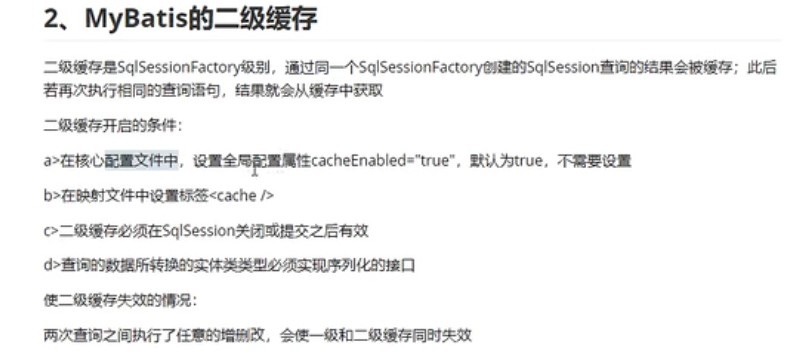
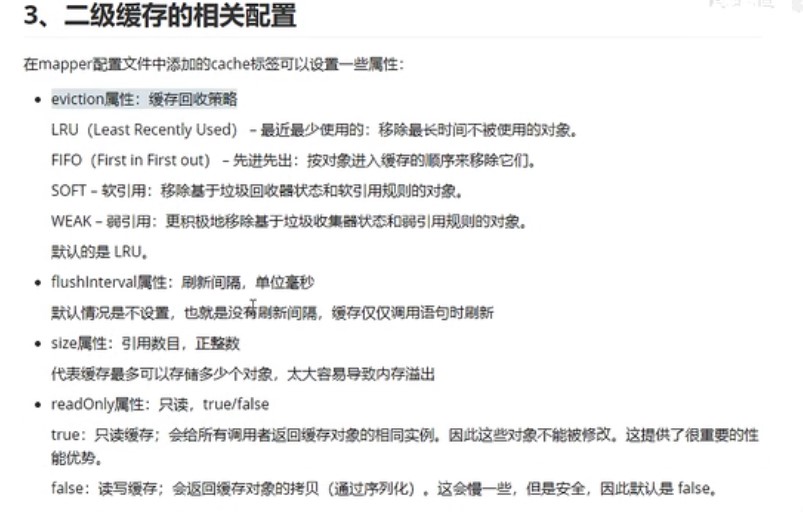

添加外部缓存
<!-- 外部缓存依赖-->
<dependency>
<groupId>org.mybatis.caches</groupId>
<artifactId>mybatis-ehcache</artifactId>
<version>1.2.2</version>
</dependency>
<!-- slf4j日志门面(提供接口)的一个具体实现-->
<dependency>
<groupId>ch.qos.logback</groupId>
<artifactId>logback-classic</artifactId>
<version>1.2.3</version>
</dependency>
</dependencies>
xml
<ehcache xmlns:xsi="http://www.w3.org/2001/XMLSchema-instance" xsi:noNamespaceSchemaLocation="../config/ehcache.xsd">
<!--当二级缓存的对象 超过内存限制时(缓存对象的个数>maxElementsInMemory),存放入的硬盘文件 -->
<diskStore path="F:\Ehcache"/>
<!--
maxElementsInMemory:设置 在内存中缓存 对象的个数
maxElementsOnDisk:设置 在硬盘中缓存 对象的个数
eternal:设置缓存是否 永远不过期
overflowToDisk:当内存中缓存的对象个数 超过
maxElementsInMemory的时候,是否转移到硬盘中
timeToIdleSeconds:当2次访问 超过该值的时候,将缓存对象失效
timeToLiveSeconds:一个缓存对象 最多存放的时间(生命周期)
diskExpiryThreadIntervalSeconds:设置每隔多长时间,通过一个线程来清理硬盘中的缓存
memoryStoreEvictionPolicy:当超过缓存对象的最大值时,处理的策略;LRU,FIFO,LFU
-->
<defaultCache
maxElementsInMemory="1000"
maxElementsOnDisk="1000000"
eternal="false"
overflowToDisk="false"
timeToIdleSeconds="100"
timeToLiveSeconds="100"
diskExpiryThreadIntervalSeconds="120"
memoryStoreEvictionPolicy="LRU">
</defaultCache>
</ehcache>
|引入二级缓存
|首先在mapper.xml文件中添加
<cache type="org.mybatis.caches.ehcahe.EhcacheCache"
|配置logback文件
<?xml version="1.0"?>
<configuration debug="true">
<!-- ch.qos.logback.core.ConsoleAppender 控制台输出 -->
<appender name="STDOUT" class="ch.qos.logback.core.ConsoleAppender">
<encoder>
<pattern>[%-5level] %d{HH:mm:ss} [%thread] %logger{36} - %msg%n</pattern>
</encoder>
</appender>
<!-- 日志级别 -->
<root level="DEBUG">
<appender-ref ref="STDOUT" />
</root>
<!-- 指定局部日志级别-->
<logger name="com.jsm" level="DEBUG"/>
</configuration>
七、mybatis的逆向工程
1、添加pom文件
<!-- 依赖mybatis核心包-->
<dependencies>
<dependency>
<groupId>org.mybatis</groupId>
<artifactId>mybatis</artifactId>
<version>3.5.7</version>
</dependency>
</dependencies>
<!-- 控制maven在构建过程中的相关配置-->
<build>
<!-- 构建过程中用到的插件-->
<plugins>
<!-- 具体插件,逆向工程的操作是以构建过程中插件形式出现的-->
<plugin>
<groupId>org.mybatis.generator</groupId>
<artifactId>mybatis-generator-maven-plugin</artifactId>
<version>1.4.1</version>
<!-- 插件的依赖-->
<dependencies>
<!-- 逆向工程的核心依赖-->
<dependency>
<groupId>org.mybatis.generator</groupId>
<artifactId>mybatis-generator-core</artifactId>
<version>1.4.1</version>
</dependency>
<!-- 数据库连接池-->
<dependency>
<groupId>com.mchange</groupId>
<artifactId>c3p0</artifactId>
<version>0.9.5.5</version>
</dependency>
<!-- mysql驱动-->
<dependency>
<groupId>mysql</groupId>
<artifactId>mysql-connector-java</artifactId>
<version>8.0.28</version>
</dependency>
</dependencies>
</plugin>
</plugins>
</build>
|配置文件
<?xml version="1.0" encoding="UTF-8"?>
<!DOCTYPE generatorConfiguration
PUBLIC "-//mybatis.org//DTD MyBatis Generator Configuration 1.0//EN"
"http://mybatis.org/dtd/mybatis-generator-config_1_0.dtd">
<generatorConfiguration>
<!-- targetRuntime:执行生成的逆向工程的版本
mybatis3Simple:生成基本的CRUD(清晰简洁版)
mybatis3:生产带条件的CRUD(奢华尊享版)-->
<!-- <classPathEntry location="/Program Files/IBM/SQLLIB/java/db2java.zip" />-->
<context id="DB2Tables" targetRuntime="MyBatis3">
<!--开启以下注释可以去掉逆向工程生成代码的注释-->
<!-- <commentGenerator >-->
<!-- <property name="suppressAllComments" value="true"/>-->
<!-- </commentGenerator>-->
<!--配置数据源-->
<jdbcConnection driverClass="com.mysql.cj.jdbc.Driver"
connectionURL="jdbc:mysql://localhost:3305/db"
userId="root"
password="2061">
</jdbcConnection>
<javaTypeResolver >
<!-- 是否使用bigDecimal, false可自动转化以下类型(Long, Integer, Short, etc.) -->
<property name="forceBigDecimals" value="false" />
</javaTypeResolver>
<!--pojo配置,targetPackage:pojo所在的包,targetProject:pojo所在的项目路径,如:myproject/src/main/java-->
<javaModelGenerator targetPackage="com.jsm.mybatis.pojo" targetProject=".\src\main\java">
<!-- 是否使用子包-->
<property name="enableSubPackages" value="true" />
<property name="trimStrings" value="true" />
</javaModelGenerator>
<!--mapper映射文件生成地址-->
<sqlMapGenerator targetPackage="com.jsm.mybatis.mapper" targetProject=".\src\main\resources">
<property name="enableSubPackages" value="true" />
</sqlMapGenerator>
<!--mapper接口生成位置-->
<javaClientGenerator type="XMLMAPPER" targetPackage="com.jsm.mybatis.mapper" targetProject=".\src\main\java">
<property name="enableSubPackages" value="true" />
</javaClientGenerator>
<!-- 配置表信息 -->
<!-- schema即为数据库名 tableName为对应的数据库表 domainObjectName是要生成的实体类 enable*ByExample
是否生成 example类
参考:
http://mybatis.org/generator/configreference/table.html-->
<!-- 更改tableName和domainObjectName就可以 -->
<table schema="DB2ADMIN" tableName="ALLTYPES" domainObjectName="Customer" >
<property name="useActualColumnNames" value="true"/>
<generatedKey column="ID" sqlStatement="DB2" identity="true" />
<columnOverride column="DATE_FIELD" property="startDate" />
<ignoreColumn column="FRED" />
<columnOverride column="LONG_VARCHAR_FIELD" jdbcType="VARCHAR" />
</table>
</context>
</generatorConfiguration>
添加mytabis-config.xml
添加jdbc.properties
添加logback.xml
|测试
@SneakyThrows
@Test
public void getAllEmp(){
InputStream is = Resources.getResourceAsStream("mybatis-config.xml");
SqlSessionFactory sessionFactory = new SqlSessionFactoryBuilder().build(is);
SqlSession sqlSession = sessionFactory.openSession(true);
EmpMapper empMapper = sqlSession.getMapper(EmpMapper.class);
// List<Emp> list= empMapper.selectByExample(null);
// list.forEach(emp -> System.out.println(emp));
// 根据条件查询
EmpExample empExample = new EmpExample();
empExample.createCriteria().andEmpNameEqualTo("jsm");
List<Emp> list=empMapper.selectByExample(empExample);
list.forEach(emp -> System.out.println(emp));
}
八、分页插件
添加pom.xml文件
<dependency>
<groupId>com.github.pagehelper</groupId>
<artifactId>pagehelper</artifactId>
<version>5.3.0</version>
</dependency>
添加mybatis-config.xml文件
<!-- 设置分页插件-->
<plugins>
<plugin interceptor="com.github.pagehelper.PageInterceptor"/>
</plugins>
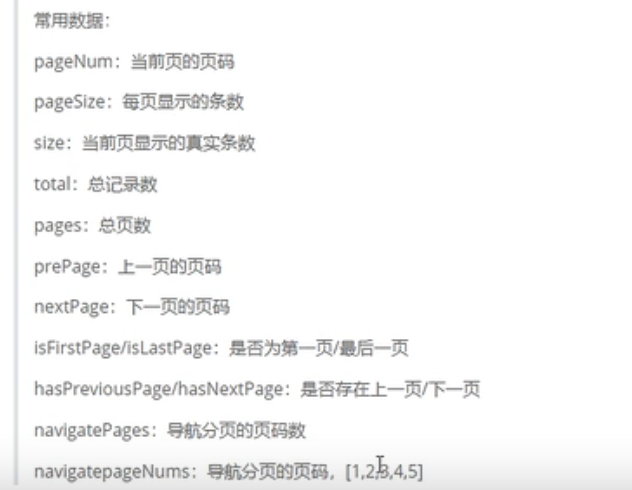
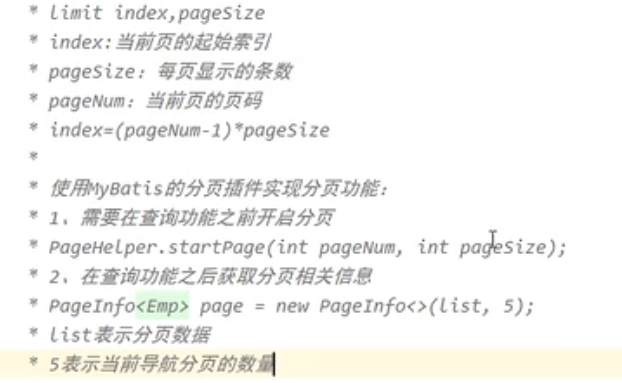
@SneakyThrows
@Test
public void getPages(){
InputStream is = Resources.getResourceAsStream("mybatis-config.xml");
SqlSessionFactory sessionFactory = new SqlSessionFactoryBuilder().build(is);
SqlSession sqlSession = sessionFactory.openSession(true);
EmpMapper empMapper = sqlSession.getMapper(EmpMapper.class);
PageHelper.startPage(3,3);
List<Emp> list=empMapper.selectByExample(null);
PageInfo<Emp> pageInfo = new PageInfo<>(list,2);
// list.forEach(emp -> System.out.println(emp));
System.out.println(pageInfo);
}
``
添加mybatis-config.xml文件
<!-- 设置分页插件-->
<plugins>
<plugin interceptor="com.github.pagehelper.PageInterceptor"/>
</plugins>
[外链图片转存中…(img-pHoZxGYR-1649840425039)]
[外链图片转存中…(img-5eog4NsF-1649840425040)]
@SneakyThrows
@Test
public void getPages(){
InputStream is = Resources.getResourceAsStream("mybatis-config.xml");
SqlSessionFactory sessionFactory = new SqlSessionFactoryBuilder().build(is);
SqlSession sqlSession = sessionFactory.openSession(true);
EmpMapper empMapper = sqlSession.getMapper(EmpMapper.class);
PageHelper.startPage(3,3);
List<Emp> list=empMapper.selectByExample(null);
PageInfo<Emp> pageInfo = new PageInfo<>(list,2);
// list.forEach(emp -> System.out.println(emp));
System.out.println(pageInfo);
}





















 3570
3570











 被折叠的 条评论
为什么被折叠?
被折叠的 条评论
为什么被折叠?








